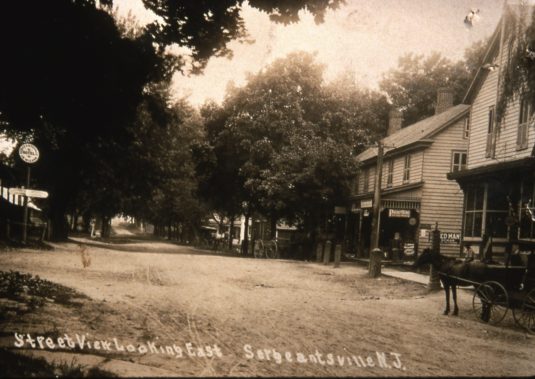Egbert T. Bush was very fond of grand old trees, and when they had to come down, he lamented the loss in his articles, including one that I published awhile ago, titled “Old Sentinel Oak Has Passed.” That huge tree, or as Bush would call it, a “Monarch,” once stood along Route 523 as you enter Stockton. Today’s article should have preceded “Old Sentinel Oak,” as it concerns the neighborhood of that great tree before it was taken down.
houses
Articles dealing with a particular house
Sergeant’s Mills, part four
This series of posts has been based on an article by Egbert T. Bush called “Sergeant’s Mills Once a Prosperous Place.” My previous post dealt with two of the four farms located in the Rosemont valley, on the north side of the road from Rittenhouse’s Tavern (Rosemont) to Skunk Town (Sergeantsville), otherwise known as Route 604. This post will describe the owner of the third farm, and include the rest of Mr. Bush’s article.
Sergeant’s Mills, part one
In a recent post on the life of John P. Rittenhouse, I mentioned that his parents, Samuel & Hannah Rittenhouse, lived near the covered bridge in Delaware Township. This reminded me of the interesting article written by Egbert T. Bush about the history of the area around Sergeant’s Mill.
John P. Rittenhouse, part two
For three years John P. Rittenhouse owned my small farm in Delaware Township, although he never lived there. As I started to research his life I discovered that, among other things, he was a Hunterdon Co. Sheriff, managed a restaurant at the Union Hotel, and then ran the hotel in Ringoes. He had an interesting life.
In 1859 he sold my farm to Edmund Perry, a successful politician, but a failure as an investor. I published the beginning of Rittenhouse’s story in the previous post, ending with a situation in which Rittenhouse, acting as deputy sheriff, had to take possession of the very farm he had previously sold to his political ally, Edmund Perry, and sell it to the highest bidder. Awkward.
Brookville & Horne’s Creek
In 1929, Egbert T. Bush wrote an article about the neighborhood of Brookville, a hamlet just south of Stockton, on the Delaware River. It seems appropriate to publish the article now because it discusses a neighborhood near the homes of John and Gershom Lambert, who’s farms were described in my previous posts (The Two Lambert Farms, Sen. Lambert’s Farm and The Gershom Lambert Farm). It also happens that Mr. Bush himself lived not far from Brookville; his farm was on Sandy Ridge Road close to Route 523, just north of Stockton.
Sen. Lambert’s Farm, pt 2
A continuation of the article on Sen. John Lambert’s home farm.
Having discovered which of two farms belonged to Sen. John Lambert, I realized how amazingly interconnected the Lambert family was. That will hold true even more so here in part two. However, I have not done all the research that could have been done before publishing this article. It was a question of when to stop.
Two Lambert Farms
There are two farms in southern Delaware Township that are particularly interesting. They were part of the old Dimsdale proprietary tract north of Lambertville until 1750, when John Lambert, a recent immigrant from Connecticut, purchased it.
A Sergeantsville History
 While working on a history of the Sergeantsville Inn, I realized that this would be a good time to publish Egbert T. Bush’s article about the places that made Sergeantsville such an interesting little town. Mr. Bush did not have the advantage of adding photographs the way I do. These pictures come from the postcard collection of Paul Kurzenberger. (Note that Mr. Bush’s article is in italics; my comments are not.)
While working on a history of the Sergeantsville Inn, I realized that this would be a good time to publish Egbert T. Bush’s article about the places that made Sergeantsville such an interesting little town. Mr. Bush did not have the advantage of adding photographs the way I do. These pictures come from the postcard collection of Paul Kurzenberger. (Note that Mr. Bush’s article is in italics; my comments are not.)
Farewell, Relic of Another Age
Burning of the Old Wagner Homestead Prompts
Mr. Bush to Cite Its History
Was Prized By Its Owners
by Egbert T. Bush, Stockton, N.J.
published in the Hunterdon Co. Democrat, January 19, 1933
Note: This article was published two years after Mr. Bush’s previous article on the Moore homestead plantation, “Old Farms in Old Hunterdon.”
The Moore Family
I have written a few articles recently concerning the neighborhood of Bowne Station (“The Daybooks of Dr. Bowne,” “The Bowne Homestead,” “Bowne Station” and “The Bosenbury and Taylor Graveyards”), and have frequently come across references to the first settlers in that area, one Jacob Moore and his wife, Apolonia Amy Moret. Just when I thought I had published all articles by Egbert T. Bush and Jonathan M. Hoppock pertaining to the early history of the Moore family in Amwell, another one turned up. Actually, two articles, “Old Farms in Old Hunterdon” and “Farewell Relic of Another Age.”